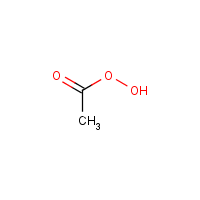Peroxyacetic acid
Agent Name
Peroxyacetic acid
Alternative Name
Peracetic acid
CAS Number
79-21-0
Formula
C2-H4-O3
Major Category
Other Classes

Synonyms
Peracetic acid; Acetic peroxide; Acetyl hydroperoxide; Acide peracetique [French]; Acide peroxyacetique [French]; Acido peroxiacetico [Spanish]; Desoxon 1; Estosteril; Ethaneperoxoic acid; Hydroperoxide, acetyl; Kyselina peroxyoctova [Czech]; Monoperacetic acid; Osbon AC; PAA; Peroxoacetic acid; Proxitane 4002; Ethaneperoxic acid; Peroxyacetic acid, >43% and with >6% hydrogen peroxide; [ChemIDplus] UN3105
Category
Peroxides, Organic
Description
Colorless liquid with an acrid odor; [HSDB]
Sources/Uses
Used as a bleaching agent of paper and textiles, a catalyst of polymerization, a fungicide, and a chemical intermediate; [HSDB] Also used as an oxidizing agent in organic synthesis; [Merck Index] Used as a disinfectant/sanitizer for food, industrial, medical, and residential applications; [Reference #2] Used to sterilize reusable medical and dental equipment; [ACGIH]
Comments
Highly corrosive to skin; [Quick CPC] Commercial solution is peracetic acid, hydrogen peroxide, acetic acid, and water (at equilibrium); [Merck Index] May decompose violently from shock, friction, or concussion; A strong oxidizing agent that reacts violently with combustible substances; Corrosive to skin, eyes, and respiratory tract; Inhalation may cause pulmonary edema; [ICSC] Does not exist in pure (100%) form; Commercially available as an equilibrium solution, distilled product (mainly peracetic acid and water), and can be generated in situ with an activator and a persalt dissolved in water; [OECD SIDS] Occupational asthma confirmed by broncho-provocation testing in two endoscopy unit workers exposed to peracetic acid/hydrogen peroxide mixture; [Malo] TLV Basis: Irritation (upper respiratory, eye, and skin); [ACGIH] Available in 40% solution; Causes severe burns; Inhalation of high concentration can cause injury to the upper respiratory tract; [MSDSonline]
Reference Link #1
Biomedical References
Exposure Assessment
STEL (ACGIH)
0.4 ppm, inhalable fraction and vapor
MAK
0.1 ppm
Vapor Pressure
14.5 mm Hg
Lethal Concentration
LC50 (rat) = 204 mg/m3/4hr
Explanatory Notes
The Guide in the Emergency Response Guidebook is for "Organic peroxide type D, liquid." VP from HSDB;
Reference Link #2
NFPA
high ambient temp required
Adverse Effects
Asthma
Yes
Toxic Pneumonitis
Yes
Dermatotoxin
Skin burns
ACGIH Carcinogen
Not Classifiable
Diseases, Processes, and Activities Linked to This Agent
Diseases
Occupational diseases associated with exposure to this agent:
Processes
Industrial Processes with risk of exposure: